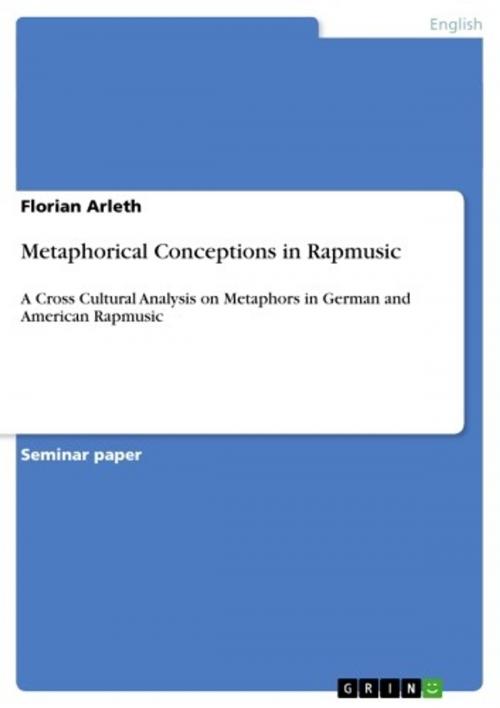Metaphorical Conceptions in Rapmusic
A Cross Cultural Analysis on Metaphors in German and American Rapmusic
Nonfiction, Entertainment, Drama, Anthologies| Author: | Florian Arleth | ISBN: | 9783656153078 |
| Publisher: | GRIN Verlag | Publication: | March 15, 2012 |
| Imprint: | GRIN Verlag | Language: | English |
| Author: | Florian Arleth |
| ISBN: | 9783656153078 |
| Publisher: | GRIN Verlag |
| Publication: | March 15, 2012 |
| Imprint: | GRIN Verlag |
| Language: | English |
Seminar paper from the year 2011 in the subject English Language and Literature Studies - Linguistics, grade: 1,3, University of Heidelberg (Anglistisches Seminar), course: PS II 'Cultural Dimensions of Language Variation and Communication', language: English, abstract: In recent studies on cultural aspects of languages, subcultures have been given more and more importance. On the metaphorical potential of such groups, Kövecses noted that Subcultures develop their own metaphors, and these metaphors may define the group. There is of course no subculture that defines itself through an entirely new set of metaphors, but some of the metaphors members use may be new relative to the mainstream (Kövecses 2009: 286f). And this might be especially true for the subculture of Hip Hop with its most important manifestation being rap music. Despite the fact that the genre is in existence since the Seventies, linguistic studies in this field are still rare, and investigations into the metaphorical inventory of rap music literally not existent. A first and important step into that direction has been undertaken by Scott Crossley, whose study shows the linguistic potential of rap music as well as its variety of metaphors: As a product of a historically oral culture that embodies familiar metaphorical traits [...], African American rap music is especially rich in metaphoric language. Its roots, along with other African American linguistic traditions (including signifying, the dozens, and narrativizing), give rap music its exceptional linguistic variety (Crossley 2005: 503). The present term paper will continue Crossley's research on metaphorical conceptions in rap music by illustrating further conceptual metaphors, but it also likes to develop it into a new direction by including German rap music as well. The relationship between American and German rap music is especially interesting because it is coined by a linguistic impact that is by far not as strong on a more general level. Certain aspects of this impact have already been laid down in earlier papers1, and it will be most rewarding to explore its cognitive dimensions as well. In the analysis three metaphorical concepts will be examined. They are illustrated with the help of similar conceptions from everyday language and from an exemplary rap music corpus that is more clearly defined in the next chapter. The methodical points of the analysis are laid down in this chapter as well. And since the metaphorical conceptions in rap music 'are generally specific to the subculture that either adopts them from the dominant culture or creates them to address their own cultural needs' (Crossley 2005: 501), variations on an intra cultural level will be noted as well.
Seminar paper from the year 2011 in the subject English Language and Literature Studies - Linguistics, grade: 1,3, University of Heidelberg (Anglistisches Seminar), course: PS II 'Cultural Dimensions of Language Variation and Communication', language: English, abstract: In recent studies on cultural aspects of languages, subcultures have been given more and more importance. On the metaphorical potential of such groups, Kövecses noted that Subcultures develop their own metaphors, and these metaphors may define the group. There is of course no subculture that defines itself through an entirely new set of metaphors, but some of the metaphors members use may be new relative to the mainstream (Kövecses 2009: 286f). And this might be especially true for the subculture of Hip Hop with its most important manifestation being rap music. Despite the fact that the genre is in existence since the Seventies, linguistic studies in this field are still rare, and investigations into the metaphorical inventory of rap music literally not existent. A first and important step into that direction has been undertaken by Scott Crossley, whose study shows the linguistic potential of rap music as well as its variety of metaphors: As a product of a historically oral culture that embodies familiar metaphorical traits [...], African American rap music is especially rich in metaphoric language. Its roots, along with other African American linguistic traditions (including signifying, the dozens, and narrativizing), give rap music its exceptional linguistic variety (Crossley 2005: 503). The present term paper will continue Crossley's research on metaphorical conceptions in rap music by illustrating further conceptual metaphors, but it also likes to develop it into a new direction by including German rap music as well. The relationship between American and German rap music is especially interesting because it is coined by a linguistic impact that is by far not as strong on a more general level. Certain aspects of this impact have already been laid down in earlier papers1, and it will be most rewarding to explore its cognitive dimensions as well. In the analysis three metaphorical concepts will be examined. They are illustrated with the help of similar conceptions from everyday language and from an exemplary rap music corpus that is more clearly defined in the next chapter. The methodical points of the analysis are laid down in this chapter as well. And since the metaphorical conceptions in rap music 'are generally specific to the subculture that either adopts them from the dominant culture or creates them to address their own cultural needs' (Crossley 2005: 501), variations on an intra cultural level will be noted as well.















